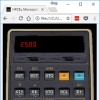What is it?
The HP-25 was the first programmable calculator in the “Woodstock” series.
For the most part, the Woodstocks were smaller, lighter and easier to carry around than their “classic” series predecessors. They ran off smaller, 3V, battery packs instead of 4.5V (3 batteries per pack) ones.
Internally, it had a new CPU (called an ACT chip for “Arithmetic, Control and Timing”) and merging parts together also made it smaller.
The HP-25 had 49 steps of program memory. These were fully merged key codes where a number of key strokes would be stored as a single instruction. In my opinion, this was significantly better than earlier approaches (used in the classic series) where, in at least some cases, a single key sequence occupied more than one program step. There’s the obvious benefit of being able to do more with merged key codes; but there’s also some “gotcha”s with jumping into the middle of what should be part of a multi-step key code.
The ’25 didn’t have labels. Instead you’d jump (GTO) to specific program step numbers. This mean’t that edits often required updating GTO targets. That was a bit messy but it worked and we learnt to plan out programs instead of just typing them in as we thought through them.
After the HP-25 was released, they released the HP-25C with “continuous memory”. That meant the calculator remembered programs (and data) even when it was switched off. At the time, that was a huge step forward. A programmable only benefited over other calculators if it had a program; and this used to mean keying one in every time you switched it on. Continuous memory meant you could load the most useful one, in some cases – ones, and just use them for weeks or more.
It was a great calculator to learn with.
There is a bit more on the HP-25 calculator at the HP-25 wikipedia page and the hpmuseum.org HP-25 page and HP-25C page.
Where do I get one?
They should be pretty rare these days as they haven’t been made for 40 years. You might find some advertised online but those that appreciate them tend not to sell them. Panamatik.de is able to repair dead ones so you might be able to find one of those and get it fixed.
However, the easiest way to experience one, or relive the memories of one, is to use an emulator – see below.
How do I use it?
The Owner’s handbook is available from sliderulemuseum.com though, if you’ve used one before, it should be almost instinctive.
How does it work?
I am slowly adding articles on the HP-25 internals.


